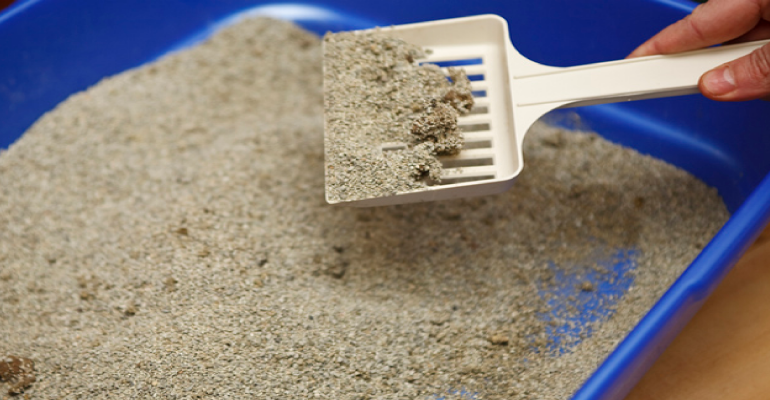
Most modern kitty litter is composed of mined clay minerals. Different clay minerals have different properties, hence we have clumping and non-clumping kitty litter. Good kitty litter absorbs both moisture and odor.
The use of clay for kitty litter was invented by Edward Lowe in 1947. A neighbor asked for some sand to use as cat litter. Her sand pile was frozen so she had been using ashes but they tracked all over her house. Instead of sand, Lowe gave her some clay called Fuller’s Earth, a set of clay minerals capable of absorbing their weight in water. (See story here).
Clay minerals are hydrous aluminum phyllosilicates that may contain other elements such as iron, sodium, and magnesium. “Phyllosilicate” means that the crystal is a flat sheet like the mineral mica. Clay minerals form by weathering of other minerals, by hydrothermal alteration, and by metamorphism of other minerals.
Non-clumping kitty litter:
Non-clumping kitty litter is mainly the clay mineral attapulgite (aka palygorskite) which is a magnesium aluminium phyllosilicate common in soils in the southeastern U.S. Attapulgite derives it absorbency from its needle-like, 3-dimensional crystal structure (which is described in exhausting detail in this paper). The packing of the needles make this mineral highly porous and absorbent. Besides its use in kitty litter, this clay is used primarily in oil well drilling fluids where it functions as a medium to remove cuttings from the well, acts as a lubricant, and forms an impervious filter cake on the walls of the hole, thus preventing loss of the fluid to porous formations. Attapulgite is also used in pharmaceutical preparations.
Clumping kitty litter:
Clumping kitty litter is made of clays in the smectite group, principally montmorillonite, which is a sodium, calcium, aluminum, magnesium phyllosillicate. It is more commonly known as Bentonite, named for the Benton Shale near Rock River, Wyoming. (BTW: “Fuller’s earth” is another group name for a variety of clay minerals.)
Unlike the needle-like structure of attapulgite, montmorillonite is a sandwich of two tetrahedral crystal sheets enclosing an octohedral crystal sheet. This structure provides great absorbency and causes the clay to swell as it absorbs moisture.
This swelling property makes montmorillonite-containing bentonite useful as an annular seal or plug for water wells and as a protective liner for landfills.
According to the Wyoming Mining Association, bentonite deposits in Wyoming comprise as much as 70 percent of the world’s known supply. Surface mining to depths no greater than about 50 feet account for all bentonite production.
Wyoming bentonite is high-swelling sodium montmorillonite clay used in kitty litter (25%), drilling mud (20%), binder in foundry molds (19%), iron ore pelletizing (13%), and other applications (23%). Wyoming Bentonite can swell up to 16 times its original size and absorb up to 10 times its own weight in water. Source
Dried silica gel is also used alone as kitty litter or added to other products. Silica gel does not clump by itself.
Your cat probably knows all this already, but doesn’t really care.
